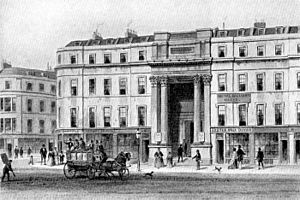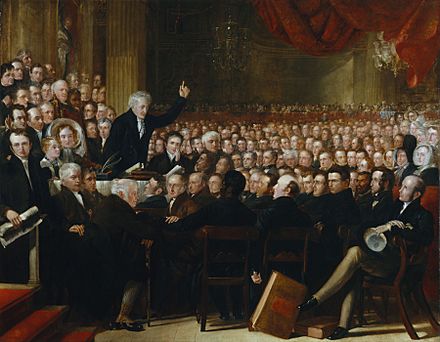World Anti-Slavery Convention facts for kids
The World Anti-Slavery Convention was a big meeting held for the first time in London from June 12 to 23, 1840. It was organized by the British and Foreign Anti-Slavery Society. A key person behind it was Joseph Sturge, a Quaker from England.
A very important outcome of this meeting was that women were not allowed to be full participants. This decision greatly helped kick off the women's rights movement in the United States.
Contents
Fighting Slavery: A Look Back

Long before this convention, people were already working to end slavery. In 1787, a group called the Society for the Abolition of the Slave Trade was formed. Most of its members were Quakers. Thanks to their efforts, the international slave trade was stopped across the British Empire in 1807. This was done through a law called the Slave Trade Act 1807.
Later, another group, the Society for the Mitigation and Gradual Abolition of Slavery, worked to end slavery completely. Their work led to the Slavery Abolition Act 1833. This law made slavery illegal in the British Empire starting in August 1834. About 800,000 people became free because of it!
In the 1830s, many people in America also felt strongly about ending slavery. They joined the abolitionist movement. Women were very active, attending meetings and writing petitions. However, some men in the movement didn't think women should be involved in politics.
A New Global Effort
Because there was a need to fight slavery all over the world, the British and Foreign Anti-Slavery Society (BFASS) was created in 1839. One of their first big actions was to organize the World Anti-Slavery Convention in 1840. They invited people from many countries to join.
More than 200 of the official delegates were British. The next largest group was from America, with about 50 delegates. Only a few people came from other nations.
A famous painting called The Anti-Slavery Society Convention, 1840 was made by Benjamin Haydon. It shows the meeting and is now in the National Portrait Gallery, London. The new society's main goal was to completely end slavery and the slave trade everywhere. They also wanted to protect the rights of people who had been freed.
Why Women Were Not Allowed to Participate
When the invitation for the convention was sent out in 1839, it caused some debate in America. Some American anti-slavery groups believed women should be allowed to take part. Others, like the supporters of Arthur Tappan, disagreed. When this second group told the BFASS they didn't want women included, a new message was sent out in February 1840. It clearly stated that the meeting was only for "gentlemen."
Despite this, many women who fought against slavery, both from America and Britain, still came to the convention. These included important figures like Lucretia Mott, Elizabeth Cady Stanton, and Lady Byron. The American Anti-Slavery Society even made sure to include Lucretia Mott and an African American man, Charles Lenox Remond, in their group of delegates.
The Debate on Women's Roles
When the convention began, Wendell Phillips suggested that the female delegates should be allowed to join the discussions. A lot of the first day was spent arguing about this. In the end, the women were allowed to sit in a special gallery to watch and listen, but they could not speak or vote.
In support of the excluded women, some American delegates, including William Lloyd Garrison and Charles Lenox Remond, refused to take their seats. They chose to sit with the women in the spectators' gallery instead.
It was at this convention that Lucretia Mott and Elizabeth Cady Stanton met. Eight years later, they would organize the very first women's rights convention in the United States.
What Happened at the Convention
The convention's organizers asked a Reverend named Benjamin Godwin to write a paper about whether slavery was right or wrong. Everyone at the convention agreed with his paper. It said that slavery was wrong and that religious leaders and communities who didn't speak out against it were also wrong. The convention decided to write to all religious leaders to share this message. They also asked all religious groups to remove any members who supported slavery.
George William Alexander shared what he saw during his visits to Sweden and the Netherlands in 1839. He talked about the terrible conditions of enslaved people in the Dutch colonies, especially in Suriname. He reported that over 100,000 enslaved people were in Suriname, and 20% of them died each year. The convention wrote protest letters to the leaders of those countries.
Joseph Pease also spoke. He said that the British government was helping slavery continue in India.
The Convention's Lasting Impact
After being denied a voice at the convention on the first day, Lucretia Mott and Elizabeth Cady Stanton walked home together. They talked about what had happened and decided right then to hold their own meeting when they returned to America. They wanted to create a group to fight for women's rights.
Eight years later, they hosted the famous Seneca Falls Convention in Seneca Falls, New York. This meeting was a huge step forward for the women's rights movement.
One hundred years after the World Anti-Slavery Convention, the Women's Centennial Congress was held in America. This event celebrated the progress women had made since they were stopped from speaking at the 1840 conference.
|


